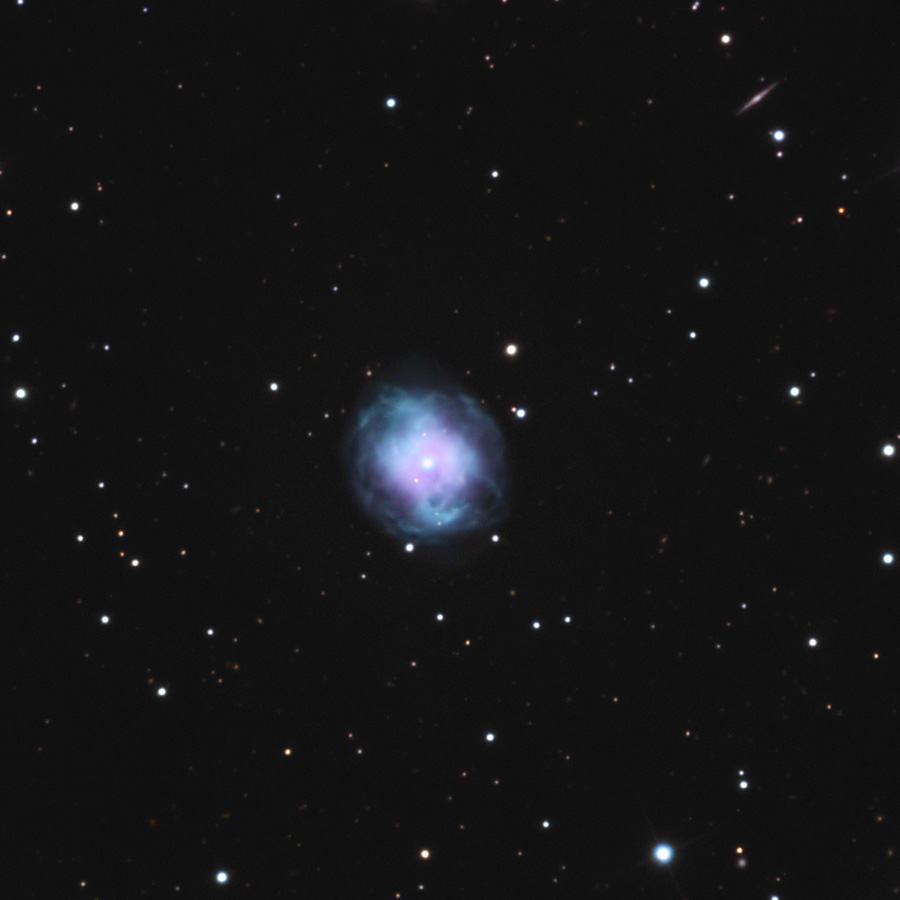
Corvus is a relatively small constellation with a handful of deep sky objects for telescopic observers.
Best seen in the spring in the northern hemisphere, and autumn in the south, it’s easily found just to the southwest of Spica, the brightest star in the constellation Virgo. Owners of larger aperture scopes should challenge themselves to locate the galaxy pairs found here, particularly NGC 4038/9, the Antennae Galaxies.
Corvus – Key Data
Name
| Latin | English | Pronunciation | Genitive | Abbreviation |
| Corvus | The Crow | COR-vus | Corvi | Crv |
Location
| Hemisphere | Best Seen | R.A. | Declination |
| Southern | Late March to Mid May | 12h 25m 11s | -18° 07’ 34” |
Features
| Area | Size Rank | # of Messier Objects | # of Stars Brighter than Mag 4 | Brightest Star |
| 184 sq. Deg. | 70th | 0 | 4 | Gamma (Gienah Corvi) Mag 2.6 |
Top Corvus Facts
- Located near the southern end of Hydra and southwest of Virgo
- The stars have been associated with a crow or a raven for thousands of years
- The Chinese saw the four brigtest stars as a chariot
- There are no Messier objects in Corvus
- Corvus is home to three pairs of galaxies, two of which are observable

Corvus in Mythology
Corvus represents a crow and is one of the original 48 constellations listed by Ptolemy. It has ties to the Greek god Apollo in at least three ways. Firstly, it’s said Apollo took the form of a crow during the war between the gods and the titans.
Secondly, according to one myth, crows originally had silver feathers. When one such crow told Apollo his lover Coronis had been unfaithful, Apollo was so enraged he banished the hapless bird to Hades and turned its feathers black.
In the third connection and best-known myth, Apollo had sent his trusty crow with a cup to fetch him some water. However, after flying to fetch the water, the crow was both hungry and thirsty, and stopped along the way back to eat figs and drink the water himself.
Knowing that Apollo would be angry if he returned with an empty cup, the crow decided to lie, rather than tell the truth. He caught a snake and then flew back, carrying the serpent in his talons and the cup in his beak.
He told Apollo he had been prevented from reaching the water by a water snake, and showed the serpent to Apollo as proof. Apollo, however, didn’t believe the crow, and threw all three – the crow (Corvus), the cup (Crater) and the snake (Hydra) – into the sky. As punishment, Corvus the crow would always go thirsty, with the cup always out of reach to the west of Corvus in the sky.

Corvus in History
The Greeks weren’t the first to see the stars of Corvus as a bird, as the Babylonians identified the constellation as a raven from at least 1100 BCE.
The constellation was sacred to Adad, the Babylonian god of rain and storm, with the stars rising in the predawn sky just before the autumnal rainy season. It’s thought the Babylonians passed this knowledge along to the Greeks around the 5th century BCE.
The Hebrews also knew it as a raven, while the Hindus saw the stars as being the hand of Prajapati, the creator lord identified with the god Brahma. The Chinese saw it as being part of a larger constellation, the Red Bird, and its four brightest stars as representing a chariot.
Later Biblical scholars linked the raven to Noah, with one joining its stars with those of neighboring Crater to form the Ark of the Covenant.
When & How to See Corvus
Corvus is best seen throughout the spring in the northern hemisphere and during the autumn months in the southern hemisphere. Given its declination on the celestial spehere, it’s best seen in the southern hemisphere, where it passes high overhead in the hours preceding midnight in May. Despite lacking any conspicuously bright stars, it’s relatively easily found, roughly 17 degrees to the southwest of bright Spica in Virgo.

Corvus’ Notable Stars
| Bayer/Flamsteed Designation | Name (s) | Mag | R.A. | Dec. | Distance (LY) | Notes |
| Gamma / 4 | Gienah Corvi | 2.6 | 12h 16m 57s | -17° 39’ 51” | 154 | Brightest star, blue-white giant. |
| Beta / 9 | Kraz | 2.7 | 12h 35m 33s | -23° 31’ 05” | 146 | Second brightest star. |
| Delta / 7 | Algorab | 2.9 | 12h 31m 01s | -16° 38’ 13” | 86.9 | Third brightest star. Multiple star. |
| Epsilon / 2 | Minkar | 3.0 | 12h 11m 16s | -22° 44’ 32” | 318 | Fourth brightest star. |
| Zeta / 5 | 5.2 | 12h 21m 43s | -22° 20’ 18” | 420 | Wide optical double with HR 4691 | |
| R Corvi | 11.0 | 12h 20m 46s | -19° 22’ 41” | 33.4 | Mira Variable with a period of 317 days | |
| VV Corvi | 5.2 | 12h 42m 25s | -13° 08’ 05” | 257 | Multiple and variable star | |
| HR 4758 | 6.4 | 12h 31m 13s | -13° 30’ 53” | 80.4 | Multiple star |
Gamma Corvi (Gienah Corvi)
Gamma is unusual in that its name – Gienah Corvi – references the constellation in which it resides. This is to distinguish it from Epsilon Cygni, which also bore the name Gienah. T
he name is derived from the original Arabic, meaning “the right wing of the raven”, but the Chinese gave it a different name. They saw the four brightest stars of Corvus as a chariot, with Gamma being known as Zhěn Sù yī, “the first star of the chariot.”
The star itself is a B8 III blue-white giant star, with a mass and diameter about four times that of the Sun and a luminosity of around 350 suns. It’s now in the later stages of its life and will most likely become a red giant within the next few million years. Gienah lies at a distance of around 150 light-years.
Beta Corvi (Kraz)
Beta Corvi, the constellation’s second brightest star, is also known as Kraz, but the origins of the name is a mystery. The name was first associated with the star in 1951, when it appeared in a star atlas compiled by the Czech astronomer Antonín Bečvář.
The Chinese, in keeping with their depiction of Corvus as a chariot, knew the star as Zhěn Sù sì, “the fourth star of the chariot.”
Kraz is a G5 II yellow giant star, with an estimated mass of three to four suns, a luminosity of 164 suns and a radius of about 16 times our Sun. It’s thought to be about 206 million years old and will eventually evolve into a white dwarf. A solitary star, Kraz is known to be an eruptive variable, with a magnitude range of between 2.60 and 2.66 over an unknown period of time. Kraz lies at a distance of 146 light-years from the Sun.
Delta Corvi (Algorab)
Delta Corvi is the constellation’s third brightest star and a multiple that’s can be easily split with small telescopes. Its name, Algorab, is Arabic and means “raven,” whereas the Chinese knew it as Zhěn Sù sān, “the third star of the chariot.”
Algorab has a companion star when observed telescopically, but it’s not been confirmed if this is a true multiple star system. The two stars appear to have the same common motion through space, which would normally indicate a binary system, but their difference in ages implies otherwise.
Telescopically, a low magnification of around 30x will show the magnitude 2.9 white primary, with the rusty magnitude 9.3 companion 24″ away. The primary is an A0 white star roughly 87 light-years away, but it’s age is uncertain. It could either be 260 million years old and evolving into a giant, or 3.2 million years old and pre-main sequence.
Epsilon Corvi (Minkar)
Epsilon Corvi, is the fourth brightest star in Corvus. It is known as Minkar, from the Arabic for “beak,” while the Chinese knew it as Zhěn Sù èr, “the second star of the chariot.” It’s a K2 III red giant star, roughly four times as massive as the Sun, with an estimated radius of about 52 times that of the Sun. Minkar lies at a distance of 318 light-years from the Earth.
Zeta Corvi
There’s nothing especially interesting in Zeta Corvi itself; it’s a run-of-the-mill magnitude 5 blue-white star, that’s nearly four times the mass, nearly four times the diameter, and 222 times the luminosity of the Sun. However, it forms a wide double with HR 4691, a magnitude 5.9 yellow-ish star.
HR 4691 is an unrelated star, 30 light-years closer than its neighbor, that appears 6 arcminutes to Zeta’s northwest. With this gap being roughly a fifth of the diameter of the full Moon, it makes the pair a decent target for binocular observers.
R Corvi
A pulsating Mira-type variable star, R Corvi ranges in magnitude from 6.7 to 14.4 over a period of 317 days. At its brightest, it can be found 1.9 degrees to the southeast of Gamma Corvi and can be seen within the same binocular field of view as that star. R Corvi is roughly 2,640 light-years away.
VV Corvi
VV Corvi is a eclipsing variable star that ranges in magnitude from 5.19 to 5.34 over a period of 3.145 days. This is caused by a close, spectroscopic companion orbiting the star and causing the magnitude to dip slightly as it passes in front of the brighter primary.
However, of greater interest to amateur astronomers is its status as a double star. The two yellow-white components are magnitude 5.9, with a separation of 5.4 arcseconds, making the pair splitable with most small telescopes. The system has an estimated distance of 257 light-years.
HR 4758
A challenging close double, you’ll find it 3.1 degrees north of Algorab. This pair comprises of a magnitude 6.4 primary and a 9.6 secondary, with a separation of just 2.1 arcseconds between them.
Corvus’ Deep Sky Objects
| Object | Name(s) | Type | Mag | R.A. | Dec. | Distance (LY) | Min. Equipment |
| NGC 4361 | Planetary Nebula | 11.0 | 12h 25m 40s | -18° 54’ 28” | 4,000 | Telescopes | |
| NGC 4038/9 | The Antennae Galaxies | Galaxies | 10.1 | 12h 03m 01s | -18° 59’ 27” | 80 Million | Telescopes |
| NGC 4027 | N/A | Galaxy | 11.1 | 12h 00m 38s | -19° 23’ 16” | 77 Million | Telescopes |
| NGC 4782/3 | Galaxies | 11.7 | 12h 55m 46s | -12° 40’ 40” | 190 Million | Telescopes |
Nebulae
NGC 4361 (Planetary Nebula)
Conveniently located 2.6 degrees southwest of Algorab and 2.4 degrees southeast of Gienah Corvi, this moderately large planetary can be detected at a relatively low magnification of around 40x.
At that magnification it appears starlike, but increase the power to around 100x and you’ll see a slightly elongated, bright disc with diffuse, undefined edges. The magnitude 13 central star can be spotted with scopes of 200mm or larger.

Galaxies
NGC 4038/9 – The Antennae Galaxies
Also known as the Ring Tail Galaxies, this is actually a pair of interacting galaxies located roughly 80 million light-years away.
The pair can be seen in small scopes, but you’ll most likely need a scope with an aperture of 200mm or larger and a magnification of at least 100x to properly study them.
NGC 4038 is the brighter and more northerly of the pair, but unless you have a scope with an aperture close to 500mm, the chances are you’ll only see a single, comma-shaped patch.
Look for texture and dark areas on its north and northwestern side, with the tail of the comma curling away to the southeast. NGC 4038/9 lies 3.5 degrees to the southwest of Gienah Corvi.

NGC 4027
Just 41 arcseconds to the southwest of the Antennae Galaxies is NGC 4027, a fainter single galaxy that lies close to the western border with Crater.
Like its neighbor, NGC 4027 gives the appearance of a comma, with a faint, irregular core and its tail extending from its western side and curving around to the north. It’s believed NGC 4027 is actually a single-armed spiral galaxy that became distorted following an interaction with the nearby (but much fainter) galaxy NGC 4027A.
At magnitude 14, NGC 4027A is theoretically also within reach of amateur equipment, but you’ll probably need an aperture of at least 400mm to see it. The two lie roughly 77 million light-years away.

NGC 4782/3
The Antennae Galaxies may be an impressive 80 million light-years, but the galaxy pair consisting of NGC 4782 and NGC 4783 have that easily beat.
At a distance of around 200 million light-years, this pair is one of the most distant deep sky sights you can observe visually.
Scopes of around 250mm and a magnification of 150x will show a single, circular patch, while apertures of 400mm or larger will give the galaxies a figure 8 appearance. Both have bright cores, with NGC 4782 being the larger of the two and NGC 4783 being the more northerly.

